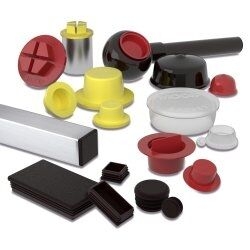What exactly are Rubber Stoppers?
- A rubber stopper is a particular kind of tiny, cylindrical or conical rubber device frequently used in industrial and scientific settings to cover gaps in containers or vessels. Natural rubber, silicone rubber, or neoprene rubber are the most common materials for rubber stoppers. These are intended to establish an airtight seal when fitted into a container or vessel.
- It may be tailored for certain uses and is available in various sizes and forms to fit different containers or vessels. They are frequently used in industrial settings to seal containers and tanks that store dangerous or volatile materials and in chemistry and biology labs to seal test tubes, flasks, and other equipment during research or storage.
- It can also be utilized in other applications, including sealing food-related containers like bottles and jars and medical equipment like catheters and syringes. They are often adaptable, strong, and resistant to chemical exposure and high temperatures, making them a vital and versatile part of many industries.
The Rewards of Rubber Stoppers’ Versatility:
Rubber stopper is useful and can be applied in a variety of situations. Although they are frequently used to seal test tubes, bottles, and laboratory glassware, their applications extend beyond the realm of the lab. The following are some of the most widespread applications and advantages of rubber stoppers:
- Sealing and protection:
Rubber stoppers are utilized to seal containers and inhibit evaporation or contamination. They can also shield the material’s contents from moisture, air, and light.
- Chemical resistance:
Rubber stoppers are resistant to various chemicals and solvents, making them perfect for use in lab environments.
- Temperature tolerance:
It can endure a wide variety of temperatures, making them perfect for applications that need exposure to intense heat or cold.
- Easy to use:
Rubber stoppers are simple to use and are the best choice for applications requiring frequent access since they are simple to insert and remove.
- Customization:
The Rubber stoppers may be made to fit certain containers or machinery, resulting in a snug and secure fit.
- Economical:
Compared to alternative solutions like plastic or metal caps, rubber stoppers are more affordable for closing containers.
- Benefits for the environment:
Rubber stoppers can be recycled and reusable, making them a sustainable option.
What is the purpose of a rubber stopper?
In many different applications across several sectors, rubber stoppers are employed. Some of their key applications are listed below:
- Testing procedures:
Test tubes, flasks, and other laboratory glassware are frequently sealed with rubber stoppers in testing procedures. They aid in keeping the surroundings sterile and free from infection.
- Pharmaceutical sector:
The pharmaceutical industry also uses rubber stoppers to seal vials and other containers that house medications. Protecting the medication from air and moisture aid in preserving its integrity and quality.
- Food and beverage sector:
Seal bottles and containers that carry liquids, such as wine bottles, soda bottles, and rubber stoppers, are employed in the food and beverage industry.
- Chemical business:
In the chemical industry, the rubber stopper is used to shut containers holding dangerous or volatile chemicals. They aid in stopping leaks and spills that could be harmful to the environment and personnel.
- Use at home:
Rubber stoppers are utilized at home for several tasks, including sealing bottles, jars, and other containers.
What properties of rubber stoppers contribute to their increased durability?
Rubber stoppers are constructed of an elastomer that, in some applications, has special qualities that make it more durable than other materials. The following qualities, among others, help rubber stoppers last a long time:
- Rubber is very elastic, allowing for both stretching and bending without breaking. As a result, rubber stoppers may be put into an aperture and mold to their shape without losing their shape or becoming harmed.
- Rubber has a high resilience, allowing it to recover its previous shape after being deformed. Rubber stoppers can tolerate continuous usage and compression because of this quality without irreversibly deforming.
- Rubber stoppers are frequently employed in chemical applications where they are subjected to various corrosive substances. Rubber has a high level of innate chemical resistance and can be exposed to acids, bases, and solvents without deteriorating.
- Rubber is capable of withstanding a broad variety of temperatures without cracking or losing its suppleness. Rubber stoppers can therefore be used in situations requiring high and low temperatures.

- Rubber is very resistant to abrasion and wear, making it ideal for use in situations where it will be repeatedly rubbed against something or rubbed against something else.
- Rubber stoppers are an all-around strong and adaptable sealing option that can survive a variety of environmental factors and chemical exposure.
The Worth of the Manufacturer Rubber stopper product design:
- Studying rubber stoppers is essential before making a buy. By investigating manufacturers, you may get the products that are best for your requirements.
- Furthermore, it will ensure that you obtain high-quality products from a reputable vendor.
- While researching manufacturers, review online reviews and consult with friends and relatives.
- By doing so, you’ll be able to evaluate the company’s product and degree of customer service. Comparing prices from different manufacturers is critical to ensure you’re getting a good deal.
Conclusion:
A rubber stopper is a multipurpose tool that may seal bottles and containers and hold objects in place. The customer may request designs and proofs from our engineers, and BRT has a 20-person, highly qualified technical staff on hand. The LFGB, IATF16949, FDA, and ROHS approve us. The warranty still covers the product, but repairs are free. BRT items are returned to the factory for repair after the warranty term has passed, the customer is responsible for covering all related expenses, including accessories, round-trip freight, customs clearance, and tax reporting. The products are supported by technical assistance for life.



